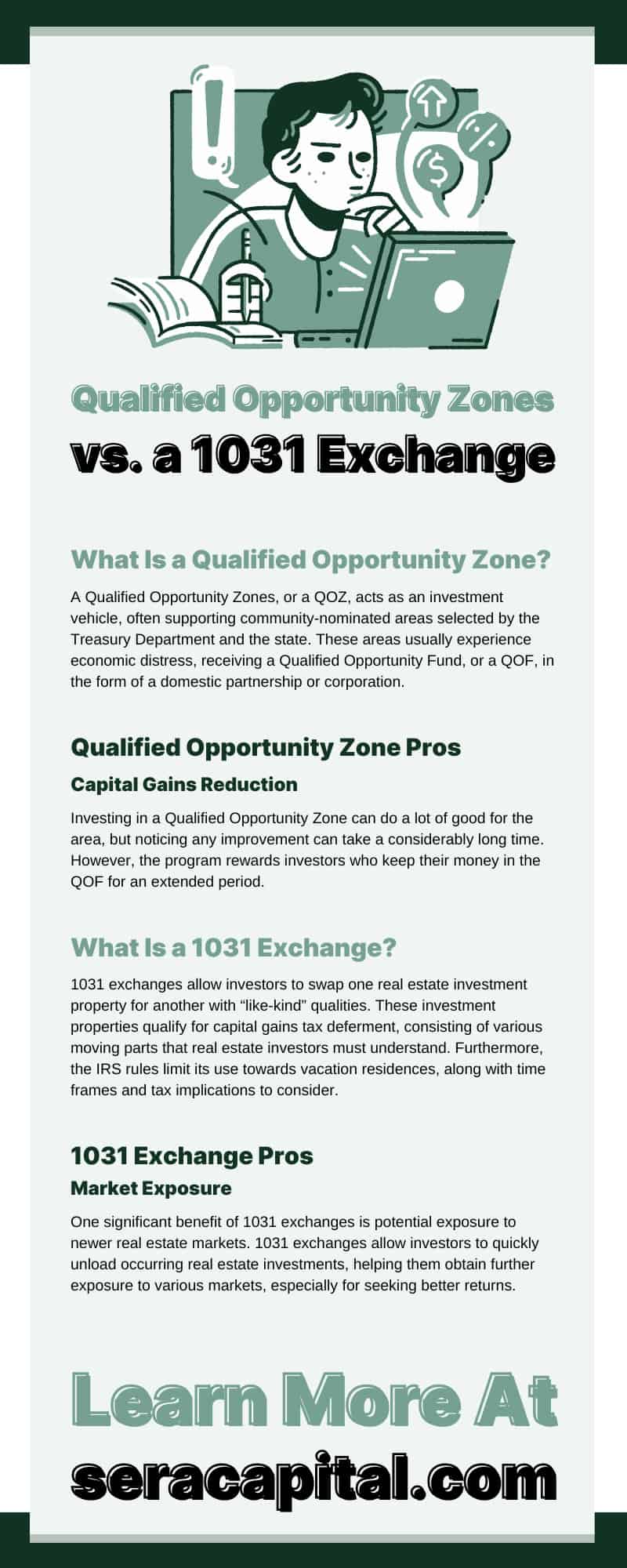Qualified Opportunity Zones vs. a 1031 Exchange

Carl E. Sera, CMT
June 28, 2023
Which is right for you: a 1031 exchange or a Qualified Opportunity Zone? Let’s review their pros and cons to determine the best action.
What Is a Qualified Opportunity Zone?
A Qualified Opportunity Zones, or a QOZ, acts as an investment vehicle, often supporting community-nominated areas selected by the Treasury Department and the state. These areas usually experience economic distress, receiving a Qualified Opportunity Fund, or a QOF, in the form of a domestic partnership or corporation.
QOFs invest indirectly through holding stocking or owning interest in businesses located in QOZs or invest directly by holding QOZ business properties. It offers taxpayers potential federal capital gains tax incentives due to long-term investment commitments, especially in low-income areas. Qualified Opportunity Zones have benefits and downsides, depending on the investor’s goals and planning.
Qualified Opportunity Zone Pros
Qualified Opportunity Zones benefit low-income areas and significantly benefit the investors who participate. Let’s review the various benefits that make QOZs so well-regarded, from capital gain reduction and tax deferment.
Capital Gains Reduction
Investing in a Qualified Opportunity Zone can do a lot of good for the area, but noticing any improvement can take a considerably long time. However, the program rewards investors who keep their money in the QOF for an extended period.
The longer the investor maintains their investment, the more benefits they get from it. For instance, investors who hold their investments for 10 years can obtain a 10 percent capital gains tax reduction. Furthermore, any appreciation won’t become subject to capital gains. While investors still pay capital gains tax on their investment a decade prior, they won’t have to pay any more tax on their investment profits.
Capital Gains Tax Deferment
One of the biggest draws to Qualified Opportunity Zones is their capital gains tax deferment benefits. Capital gains tax is one of the most infuriating parts of accumulating wealth; the better their investments perform, the higher they must pay. However, QOZs have a loophole that allows investors to defer some of their capital gains tax with generated passive income.
For instance, if investors provide a QOZ investment within 180 days of incurred capital gains, they can defer taxes on investment amounts until December 31, 2026. This permits investors to generate more income before getting forfeited to the government.
Qualified Opportunity Zone Cons
Qualified Opportunity Zones can act as a great helping hand in low-income areas. However, QOZs can also have some minor downsides. So, here are some cons that come with Qualified Opportunity Zones.
Community Investment Uncertainty
Qualified Opportunity Zones can benefit low-income areas in the United States and the investors, as the purpose is to create a beneficial investment for local communities while boosting financial returns. However, the QOZ legislation states that community leader input isn’t required for development processes.
Because of protests and legal challenges, less popular projects could become held back over others. Investors can end up funding projects that can gentrify low-income areas and raise living costs, especially without understanding the residents living in those areas.
Initially High Buy-In Costs
While some investors don’t mind the costs of QOZs, others can feel a certain uneasiness about the size of initial investment amounts can be. Since QOZs require a staggeringly high six-figure investment, they can make up most of the investor’s available wealth.
Since Qualified Opportunity Zones remain a relatively new concept, they don’t have an established track record for assessing potential investment risks. Even more so, investors may feel uncomfortable tying so much money into a long-term untested investment model.
What Is a 1031 Exchange?
1031 exchanges allow investors to swap one real estate investment property for another with “like-kind” qualities. These investment properties qualify for capital gains tax deferment, consisting of various moving parts that real estate investors must understand. Furthermore, the IRS rules limit its use towards vacation residences, along with time frames and tax implications to consider.
One significant difference between QOZs and 1031 exchanges is that 1031 exchanges apply towards real estate assets; the investor sells real estate investments and trades for replacement real estate investments. QOZs can go towards real estate, bonds, stocks, and more. 1031 exchanges act as a tax break, and a third party holds proceeds from real estate investment sales in escrow.
1031 Exchange Pros
There are many reasons why investors hold 1031 exchanges in high regard. Let’s review the various benefits of 1031 exchanges and see if it’s a suitable choice.
Market Exposure
One significant benefit of 1031 exchanges is potential exposure to newer real estate markets. 1031 exchanges allow investors to quickly unload occurring real estate investments, helping them obtain further exposure to various markets, especially for seeking better returns.
Additionally, 1031 exchanges can occur anywhere in the country, as there aren’t any restrictions based on US state lines. So, an investor can sell a property on the West Coast and use their sales funds to invest in an East Coast property. Moreover, they won’t have to pay capital gains tax at the time of the property sale.
Estate Planning
Many real estate investors often use the phrase: “swap ‘til you drop,” which refers to investors consistently swapping old properties for new ones until their passing. This allows investors to defer capital gains tax on said properties the entire time. Upon their death, this also leaves properties to heirs, who won’t have to pay capital gains tax accumulated from previous sales.
As such, heirs who inherit their properties receive a “step-up” basis, allowing them to inherit properties at current fair-market asset prices. Any gains tax accumulated will vanish, creating an optimal tool for accumulating generational wealth and having no limits on how many 1031 exchanges can occur.
1031 Exchange Cons
With so many benefits to 1031 exchanges, investors should also remain aware of potential downsides. So, here are some cons that come with 1031 exchanges that investors should remain mindful of.
Structure Complications
Overall, the 1031 exchange structure can create difficulty for investors, especially if many people become involved in real estate investment. For instance, if investors involved other parties in investments, and only a portion wanted to participate in a 1031 exchange, this could create an issue. In situations where investors and other participants in the investment want different things, it can become a complicated endeavor, resulting in a Tenancy in Common (TIC) structure.
Sera Capital provides its clients with education and guidance on real estate investments and capital gain tax deferment opportunities. Our Opportunity Zones Investment specialists offer clients exceptional exit planning tools and advice, creating a public or private partnership to allow investors to sell highly appreciated assets. We believe in helping investors by utilizing QOZs as tax-saving tools on stocks, bonds, jewelry, and so much more. For more information on our investment services and advice, contact our Sera Capital specialists today.

Categories
Strategize Your Success
